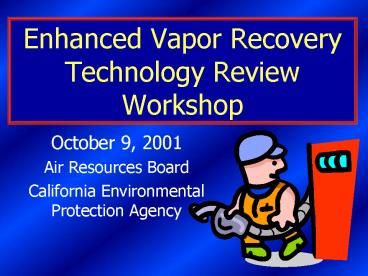Enhanced Vapor Recovery Technology Review Workshop - PowerPoint PPT Presentation
1 / 44
Title:
Enhanced Vapor Recovery Technology Review Workshop
Description:
Standards with future effective or operative dates, including ISD, nozzle ... Spill containment box drain valve. Drain valve configuration. Product and Vapor Adaptor ... – PowerPoint PPT presentation
Number of Views:181
Avg rating:3.0/5.0
Title: Enhanced Vapor Recovery Technology Review Workshop
1
Enhanced Vapor RecoveryTechnology ReviewWorkshop
- October 9, 2001
- Air Resources Board
- California Environmental Protection Agency
2
Agenda
- Introduction
- Status Report on July 2001 EVR Standards
- Criteria for Technological Feasibility
- Scope of EVR Technology Review
- Lunch
3
Agenda (cont.)
- Alternatives to EVR Standards
- Cost-Effectiveness Methodology Review
- Technology Review Schedule
- Phase I System Definition
4
Tech Review Direction from March 2000 Resolution
- Standards with future effective or operative
dates, including ISD, nozzle performance
standards ORVR compatibility - Comprehensive, thorough and rigorous
- Evaluate practical alternatives
- Hold workshops
- Complete tech review by April 1, 2002
5
(No Transcript)
6
Status on July 2001 Standards
- 350 ml/1000 gal liquid retention
- certified nozzles tested have passed
- list in EO G-70-199
- EVR Phase I
- one system certified
- EO VR-101-A
7
Scope of Tech Review
- ORVR Compatibility
- Phase II Standards
- Nozzle standards
- In-Station Diagnostics
8
Criteria for Technological Feasibility
9
ORVR Compatibility
- Refueling vehicles equipped with onboard
refueling vapor recovery shall not cause the
system to exceed the Phase II emission factor - Three Phase II systems have been certified as
ORVR compatible - Technologically feasible
10
Phase II/ORVR Compatibility Implementation
11
Standards and Specifications
- All EVR standards and specifications in CP-201
and ISD appendix initially considered - Specifications set during certification not
included
12
Phase II Standards
13
Phase II Standards
14
Phase II Standards
15
Phase II Standards
16
Phase II Standards
17
Nozzle Standards
18
Nozzle Standards
19
Nozzle Standards
20
Nozzle Standards
21
ISD Detection
22
ISD Response to System Failure
23
ISD Pressure
24
ISD Vacuum-Assist A/L
25
ISD Balance System
26
ISD Central Vacuum System
27
ISD Data and Reports
28
ISD Tampering
29
ISD Functioning
30
ISD Standardization
31
Alternatives to EVR Standards
- The technology review shall include an evaluation
of all practical alternatives to, and means of
meeting, the requirements of Enhanced Vapor
Recovery goals - Need input from stakeholders
32
Cost Methodology
- Based on EVR approach
- Described in Feb. 4, 2000 EVR Staff Report (ISOR)
- Available on webpage
- http//www.arb.ca.gov/regact/
- march2000evr/march2000evr.htm
33
Conservative Assumptions
- All vapor recovery equipment components would be
replaced - Retail list prices
- EVR nozzles will cost 75 more
34
GDF Classification
Gasoline Dispensing Facility (GDF) divided into
five groups based on throughput
35
Emission Reductions
Total EVR emission reductions 25.1 tpd
36
Cost Effectiveness
Overall Cost-Effectiveness 1.80/lb
37
RUST Program
- RUST Replacement of Underground Storage Tanks
- Low-interest loans for small businesses
- Eric Watkins (916) 323-9879
- http//commerce.ca.gov/small-business/financing/ru
st.html
38
Tech Review Schedule
- Comments by November 16, 2001
- Draft report issued in January 2002
- Workshop on February 5, 2002
- Comments due February 15, 2002
- Completed April 1, 2002
39
2002 Regulation Amendments
- Workshop in May 2002 (tentative)
- Finalize amendments in July 2002
- September 2002 Board meeting (tentative)
40
EVR Phase I Problem
- All Phase I components defined in CP-201 as
non-system-specific - Clear definition needed of what constitutes a
Phase I system - More clarity needed on testing of
non-system-specific components
41
Proposed Solution
- Determine which Phase I components should be
reclassified as system-specific - Propose modification of CP-201, Tables 16-1 and
16-2, to change the designation of those
components
42
System-Specific Phase I
- Components directly involved in fuel deliveries
to be reclassified - Spill containment box drain valve
- Drain valve configuration
- Product and Vapor Adaptor
- Drop tube overfill prevention device
43
Non-System-Specific Testing Requirements
- All components must successfully complete an
operational test of at least 180 days on a
certified system to be considered - Additional bench and/or field testing as
necessary to demonstrate compatibility with
additional system
44
EVR Contacts
- Tech Review - Cindy Castronovo
- ccastron_at_arb.ca.gov (916) 322-8957
- In-Station Diagnostics - Tom Scheffelin
- tscheffe_at_arb.ca.gov (916) 322-8922
- EVR Certification and Phase I System Definition -
Laura McKinney - lmckinne_at_arb.ca.gov (916) 327-0900































